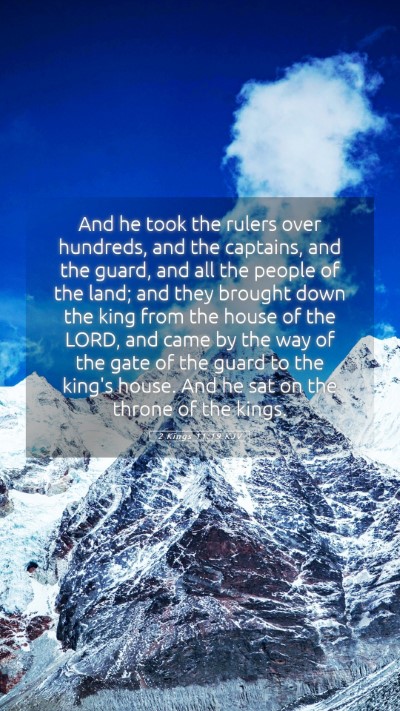Old Testament
Genesis Exodus Leviticus Numbers Deuteronomy Joshua Judges Ruth 1 Samuel 2 Samuel 1 Kings 2 Kings 1 Chronicles 2 Chronicles Ezra Nehemiah Esther Job Psalms Proverbs Ecclesiastes Song of Solomon Isaiah Jeremiah Lamentations Ezekiel Daniel Hosea Joel Amos Obadiah Jonah Micah Nahum Habakkuk Zephaniah Haggai Zechariah Malachi2 Kings 11:19 Meaning
What is the meaning of 2 Kings 11:19?
And he took the rulers over hundreds, and the captains, and the guard, and all the people of the land; and they brought down the king from the house of the LORD, and came by the way of the gate of the guard to the king's house. And he sat on the throne of the kings.
2 Kings 11:19 Bible Verse Meaning
Understanding 2 Kings 11:19
Bible Verse: 2 Kings 11:19 - "And he took the king’s children, and slew all the seed royal."
Verse Context and Overview
This verse describes the actions of Athaliah following her rise to power in Judah. After the death of her son, she took control and sought to eliminate any potential threats to her reign, specifically the royal lineage. By slaughtering the king's children, she aimed to secure her position. This action is a pivotal moment in the narrative of the monarchy in Judah, reflecting the violence and turmoil during this period.
Interpretation and Meaning
The interpretation of this verse can be enriched by insights from notable public domain commentaries:
-
Matthew Henry:
Henry emphasizes the wickedness of Athaliah’s actions and reflects on the broader themes of God's providence and judgment. Despite her despotism, God's plan for preserving the line of David is intact, illustrating that evil deeds cannot thwart divine purposes.
-
Albert Barnes:
Barnes highlights the political and spiritual implications of Athaliah’s actions, noting the disastrous consequences of such tyranny. He underscores that the slaughter of the royal seed represents a complete disregard for the covenant promises that God made to David regarding his lineage.
-
Adam Clarke:
Clarke provides historical context, discussing the sociopolitical environment of Judah during Athaliah’s rule. He points out that this massacre serves as a grim reminder of the instability in leadership and the moral decay present, as fear and ambition lead to tragic outcomes.
Bible Study Insights
From a biblical study perspective, this verse offers several insights into the nature of power, the consequences of ambition, and the importance of divine protection over His chosen people. It serves as an example for modern readers about the impact of unchecked authority and the moral obligations of leadership.
Applications to Daily Life
- Reflect on Power: Consider how individuals use power in contemporary settings, ensuring that ambition does not lead to harm.
- Seek Divine Justice: This passage motivates believers to trust in God’s overarching plan, even when human actions seem malevolent.
- Covenant Faithfulness: Emphasize the importance of remaining true to one’s commitments, reflecting God's faithfulness to His promises.
Cross References
- 2 Kings 10:7 - The context of Jehu’s purge of the house of Ahab highlights destructive political maneuvering.
- Matthew 2:16 - The slaughter of infants under King Herod symbolizes the recurring theme of power seeking to eliminate threats.
- Isaiah 14:21 - A warning about the consequences of violence against the children of a nation.
Conclusion
The events surrounding 2 Kings 11:19 serve as a somber reminder of the potential for human wickedness but also reflect God's intention to maintain His covenant with David. In understanding this verse, readers can explore profound themes of justice, power, and divine oversight, enriching their Bible study discussions and personal reflections.
Further Study Suggestions
For those wanting to delve deeper into the themes present in this verse, consider exploring:
- Historical Context: Understanding the political backdrop of ancient Judah and the significance of dynastic rule.
- Character Studies: Analyzing figures like Athaliah and Jehu for the moral lessons each embodies.
- Biblical Exegesis Techniques: Learning how to interpret the texts through historical and literary lenses, enhancing overall understanding.


